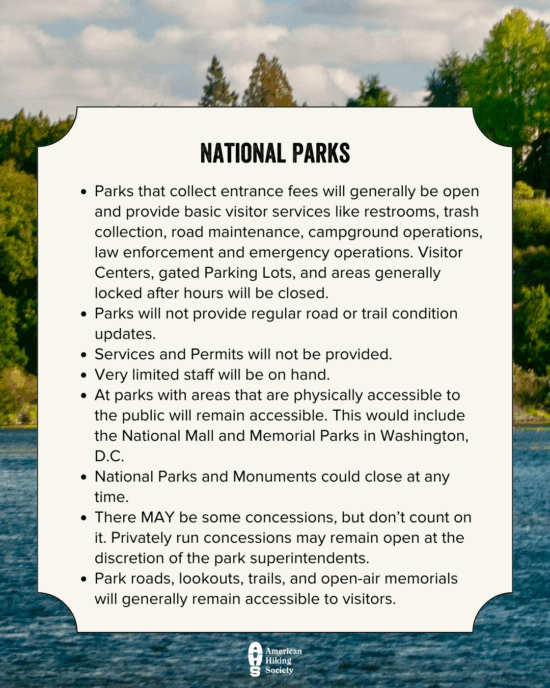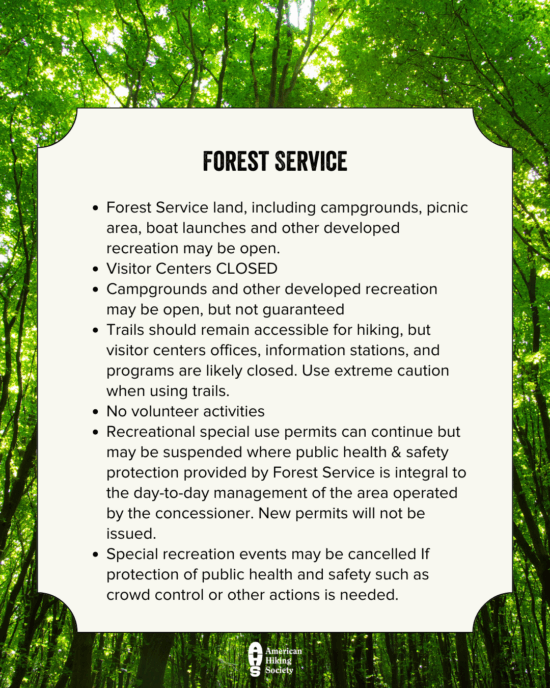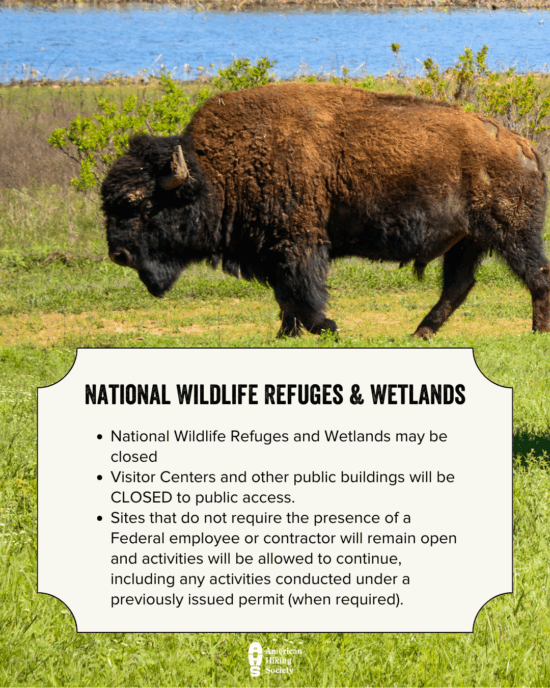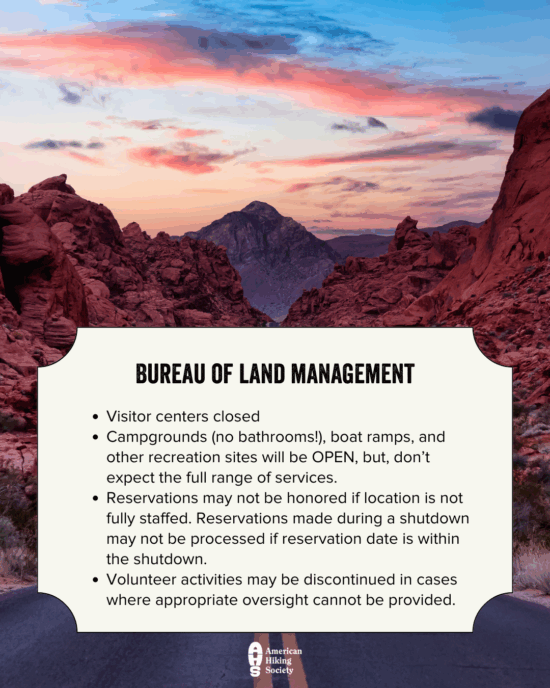A Hikers Guide to the Government Shutdown (Updated Sept. 2025)
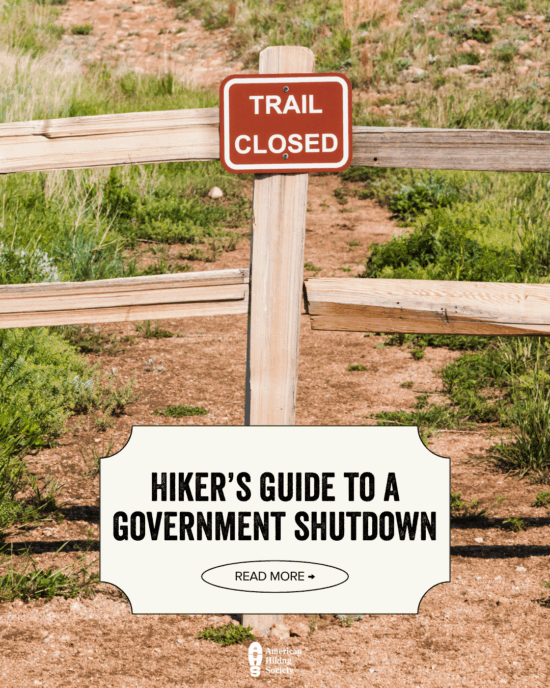 ***Please Note That This Information Could Change At Any Time***
***Please Note That This Information Could Change At Any Time***
So the government might be shutdown, now what?
Your bags are packed, the car is loaded, and you are about to set off on a nice outdoor getaway to enjoy some hiking and fresh air when you hear then news that the government has shut down and you may not be able to access your favorite trail. Don’t fear, you can likely still go out and enjoy your hike, but you will be more limited in where you can go, what resources will be available, and who will be there to assist you.
Share your shutdown hiking experience with AHS on Facebook, Twitter (@AmericanHiking), and Instagram (@americanhiking)
Below is a helpful guide to get you through a shutdown.
Bottom Line: Expect closures and limited services on federally managed lands and Use Extreme Caution.
- State and Local Parks are not impacted. The shutdown only pertains to the federal government, so any state and local parks and trails should be open for your enjoyment.
- National Park Access Will Vary Park to Park
- Parks with entrance fees will generally be open but only provide basic visitor services including restrooms, trash collection, road maintenance, campground operations, law enforcement and emergency operations. Visitor Centers, gated parking lots, and areas generally locked after hours will be closed during the shutdown.
- Places that can't be closed will remain accessible. Use Extreme Caution. Generally, where parks have accessible park areas, including park roads, lookouts, trails, and open-air memorials, these areas will remain physically accessible to the public. No visitor services will be provided. The NPS will not issue permits, conduct interpretive or educational programs, collect trash, operate or provide restrooms, maintain roads and walkways (including plowing and ice melting) or provide visitor information.
- Park website and social media will not be maintained.
- Permits will not be provided
- National Parks and Monuments could close at any time. If visitor access becomes a safety, health or resource protection issue (weather, road conditions, resource damage, garbage build-up to the extent that it endangers human health or wildlife, etc.), the area must be closed.
- There MAY be some concessions, but don’t count on it. Privately run concessions may remain open at the discretion of the park superintendents.
- Bureau of Land Management
- Visitor Centers Closed on a Site-Specific Basis The operation of each facility must be evaluated on a site-specific basis and any contractual requirements.
- Campgrounds (no bathrooms!), boat ramps, and other recreation sites will be OPEN, but, don't expect the full range of services including restrooms and water systems. In cases where funds are not available to maintain such services, signs will be posted but visitors may remain at these sites at their own risk.
- Reservations May Not Be Honored if location is not fully staffed. Reservations made during a shutdown may not be processed if reservation date is within the shutdown.
- Volunteer activities may be discontinued in cases where appropriate oversight cannot be
provided.
- National Wildlife Refuges and Wetlands MAY be CLOSED
- Visitor Centers and other public buildings will be CLOSED to public access.
- Sites that do not require the presence of a Federal employee or contractor will remain open and activities will be allowed to continue, including any activities conducted under a previously issued permit (when required).
- No permits may be issued or reviewed; most visitor events will not take place; habitat restoration activities will be put on hold, and most of the normal work of the Service will be discontinued.
- Forest Service land, including campgrounds, picnic area, boat launches and other developed recreation may be open.
- Public access to recreation sites would be reduced.
- Visitor Centers CLOSED
- Campgrounds and Other Developed Recreation May, But Not Guaranteed, To Be Open. Site by Site Determination Likely Forest Service may provide critical health, public safety and protection services in a manner that maintains restrooms and sanitation, trash collection, road maintenance, campground operations, law enforcement emergency operations, and the protection of natural resources.
- Trails Should Remain Accessible for Hiking, but visitor centers offices, information stations, and programs are likely closed. Use Extreme Caution.
- No Volunteer Activities Volunteer activities are discontinued during the shutdown. Volunteers that are housed in Forest Service housing will be allowed to remain there, but will not do any project work or be otherwise compensated.
- Recreational Special Use Permits Can Continue but may be suspended where public health & safety protection provided by Forest Service personnel is integral to the day-to-day management of the area operated by the concessioner. New permits will not be issued.
- Special Recreation Events If protection of public health and safety such as crowd control or
other actions is needed, and the permittee can provide that through private means, then the event can be sustained. Otherwise, the special recreation event will be cancelled.
- Check to see if the park, monument, land, or trail is open before you go.
- While it may be difficult to get updates, try calling, check social media reports (official account won't be updated), or ask a friend before heading out. Additional information on Department of the Interior (BLM, National Parks, Fish and Wildlife) and the Forest Service plans for the shutdown are available.
- Share your shutdown hiking experience and conditions with AHS on Facebook, Twitter (@AmericanHiking), and Instagram (@americanhiking)
- MOST IMPORTANTLY STAY SAFE
Article by, Tyler Ray, Director of Policy and Advocacy at American Hiking Society

